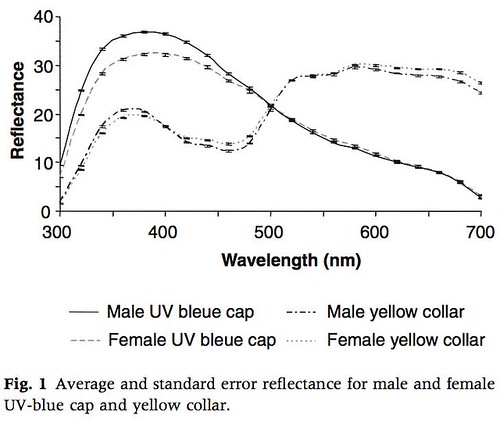tags: researchblogging.org, blue tits, Cyanistes caeruleus, Parus caeruleus, sexual selection, mate choice, ornithology, female coloration, reproduction, maternal quality, evolution, birds, ornithology
In many bird species, the females are brightly colored, just as the males are, but the evolutionary reasons for brightly colored females is unclear. According to one hypothesis, because males and females share the same genome, their traits are similar. However, according to another hypothesis, there may also be selective pressures on females, just as there are on males, to develop brightly colored plumages and ornaments. Basically, male birds are brightly colored because females clearly prefer them, but do males also choose females with brighter plumages? Is it possible that females, like males, advertise their genetic quality by having more colorful plumages or more elaborate ornaments?
Claire Doutrelant, at the Center for Functional Ecology and Evolution in Montpellier, France, and her colleagues, wondered the same things, so they experimentally investigated whether brighter coloration reflects the breeding capacity in female blue tits. Because female blue tits build the nests, lay and incubate the eggs, and feed the chicks, they typically investment more into each reproductive effort than do their mates, who only assist with feeding the chicks. Because these activities occur shortly before the birds moult and because replacing feathers is so energetically costly, it seems logical to assume that plumage coloration would reflect a female's overall health and reproductive quality.
Doutrelant and her colleagues predicted that female blue tits with brighter plumages would be more likely to successfully build a replacement nest and produce another clutch of eggs following the loss of their original nest and eggs. To test this hypothesis, the team followed the link between female coloration and the key indicators of avian lifetime reproductive success (i.e.; laying date, clutch size, local recruitment and adult local survival) for 80 pairs of birds, half of which had their nests and eggs removed after five days incubation.
The coloration of the birds' plumages was quantified by plucking six blue cap feathers and six yellow collar feathers from each study bird. These feathers were analyzed to determine the intensity of coloring from 300-700 nm (wavelengths of the visible light spectrum). Feathers from the females were compared to those of males (figure 1, below);
[larger]
Even though some differences in intensity of blue coloration were noted between females, these differences were correlated with only two variables studied. Females with brighter blue cap feathers showed improved adult survivorship from one season to the next along with a marginal correlation with an earlier initation of egg laying.
When the team analyzed yellow feather coloring, they found that intensity was tightly associated with the experimental females' ability to produce a larger replacement clutch of eggs after her first nest was lost (dotted line, figure 2, below), whereas no difference in clutch size was noted for control females (solid line), whose nests were left unmolested by the researchers;
[larger]
Additionally, several other studies revealed that fledglings produced by brighter yellow females had a better survival rate and they were more likely to be found on breeding territories the following year, also known as "local recruitment" (data not shown).
So, according to these results, brighter plumage in female blue tits provides non-redundant signals regarding female quality. Because yellow coloring is the result of pigments, known as carotenoids, being added to newly growing feathers and because carotenoids are obtained directly from a high-quality diet, brighter yellow plumage accurately reflects a female's general body condition and her overall foraging efficiency. Further, brighter blue plumage is the result of a structural plumage color that is probably also dependent upon the bird's body condition.
Thus, this research found that female blue tits use pluamge coloring as an honest signal to indicate their overall reproductive quality to potential mates. Since males are similarly colored, it will be interesting to learn if they too are using coloring in the same way to signal their quality to females.
This study was recently published online in the Journal of Evolutionary Biology.
Source
C. Doutrelant, A. Gregoire, N. Grnac, D Gomez, MM Lambrechts& P Perret. Female coloration indicates female reproductive capacity in blue tits. (2008). Journal of Evolutionary Biology 21: 226 - 233 | doi: 10.1111/j.1420-9101.2007.01451.x (figures).
- Log in to post comments



Are tits cavity nesters, like their relatives in the US? If so, the bright colors would not be a disadvantage to the brooding parent.
IOW, it's my understanding that the females of many species are less colorful because they incubate the eggs, and would be to easy to spot if they contrasted too much with foliage and such. In species where the male incubates, such as phalaropes and jacanas, the male has subdued colors, and the female is brightly colored.
yes, indeed they are cavity nesters! good call.
Best headline of the week!
GS, are you milking the search engines again? ;-)
I'm too old to worry about the nit-picking science involved with coloration of female Bluetits. But Bluetits (Blaumeisen) were a favorite of mine when I was stationed in Germany. My (ex)mother-in-law had a feeder on her porch railing that lured them close to her living room for easy observation.